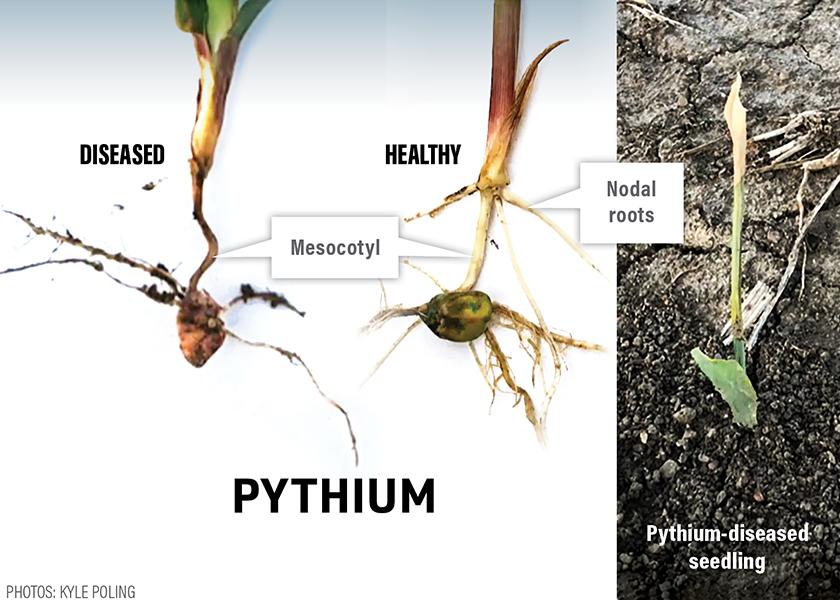Corn Seedling Diseases Don't Seem Dramatic, But The Yield Losses they Cause Sure Are

In the world of corn diseases, some get the bulk of farmer attention and most of the press coverage because of their dramatic impact on corn. Think tar spot.
Creating significant yield loss but less consternation – because they’re literally underground – are corn seedling diseases, particularly Pythium, Fusarium and Rhizoctonia.
Of the three, Pythium comes to the top of the list, according to Dale Ireland, technical product lead for Syngenta Seedcare.
“Pythium is the No. 1 seedling disease threat for corn, causing more damage than Fusarium and Rhizoctonia seedling diseases combined,” Ireland says.
Infection from Pythium (more than 50 known Pythium species exist) is favored by cool (<55 F), wet soil conditions.
Infections result in damping off — the leading cause of yield loss in corn, Ireland says — as well as “reduced plant stands, lower plant populations and reduced yield potential.”
Look For The Symptoms
Growers are often tipped off to Pythium’s presence when what were initially uniform fields of corn become erratic in plant height and growth stage—usually between the V1 and V3 growth stages, says Kyle Poling, Pioneer field agronomist.
He says four common signs Pythium is present are:
1. A plant whose top leaf growing out of the whorl is wilted or dead.
2. The entire plant is wilting.
3. The plant whorl is tightly wrapped and not opening.
4. There are gaps in the row where entire plants are missing.
The impact of Pythium in a crop is particularly critical at about the V2 corn growth stage, Poling says.
“This is a critical time in a corn plant's life as it's transitioning from the primary root system – comprised of the radical root and seminal roots – over to the nodal roots, the permanent root system, which will provide the bulk of the water and nutrients throughout the plant's life,” he says.
Poling adds that if the mesocotyl becomes diseased, it can be extremely difficult for a corn plant to smoothly and successfully transition to the nodal root system.
Younger Plants Fare Poorly
Several factors influence how well an infected corn plant will recover. Those include growth stage at the time of infection, growing conditions following infection, and plant vigor or early growth characteristics of the hybrid.
“Plants that are infected (by Pythium) at the V1 growth stage or earlier will have a tougher time developing the nodal roots than those plants at the V2, V3 or later growth stages,” Poling says.
Growth of infected plants that survive is usually stunted to the point they are at a disadvantage to compete with neighboring corn plants for light, water, nutrients, thus lowering yield potential, he adds.
Options For Prevention
For farmers looking to prevent seedling disease, including Pythium, agronomists recommend using a fungicide-containing seed treatment. Common options are those that contain metalaxyl or ethaboxam.
New and upcoming options to fight seedling disease:
1. Syngenta Seedcare recently introduced a novel mode of action to the marketplace with picarbutrazox, called Vayantis. Approved by EPA for use, the company says it offers the most robust Pythium protection ever, compared to existing oomycete protection molecules – metalaxyl or ethaboxam – based on extensive lab testing of over 400 Pythium isolates.
2. For 2023, Corteva plans to offer Lumiscend Pro fungicide seed treatment. It will be partnered with ipconazole fungicide seed treatment and L-2012 R biofungicide. The company says this combination will offer farmers two modes of action for pythium, three modes of action for rhizoctonia and fusarium, and one mode of action against head smut.
3. In the biological arena, DPH Biologicals just introduced a multi-action biofungicide seed treatment for use in 2023 - BellaTrove Companion Maxx ST - that helps seedlings fight pathogens and ensures healthy root systems. The EPA-registered OMRI-certified biofungicide and bactericide stimulates a plant’s natural defenses against pathogens while improving nutrient uptake and root health, the company says.
Plant pathologists increasingly recommend using two modes of action against Pythium along with integrated management practices. The combination is often necessary to prevent severe infestations, according to Nathan Mueller, University of Nebraska Extension agronomist. Even then, he adds, seedling disease “may still develop, such as during extended periods of inclement weather or severe pathogen pressure.”
Ferrie: Assess Your Risks for Tar Spot this Season
Up Your Average: Tips to Raise Yields Across Your Farm
Corn Yield Losses to ‘Edge Effect’ Elevated by Contrary Micro-Climate and Weather Patterns







